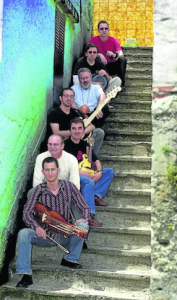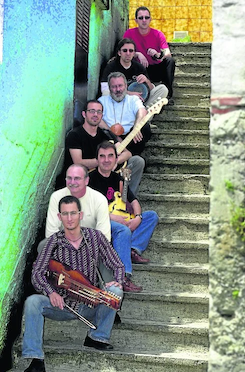I’ve written about how, when I returned from my year in the Basque Country, I sort of shocked my dad by playing some Basque punk. However, I also came back with some folk music, including Oskorri. This, my dad could get in to. When he left the Basque Country, they didn’t have recordings of all of this music that he grew up with, so, when I was growing up, he never listened to any of it. Having a few CDs of music like Oskorri changed that for him, returned a little flavor of the Basque Country he grew up in.

- Oskorri was created in 1971 by Natxo de Felipe, performing their first concert at the University of Deusto in March of that year. Their first album, released in 1976, was based on the poems of Gabriel Aresti. In their early years, during the time of transition from Franco’s dictatorship, their music was much more political and combative, reflecting their (and Aresti’s) leftist sympathies, though with time their message mellowed.
- During those first years, the police and the Guardia Civil would show up to disperse the crowds, including through beating concert goers. However, they also received pressure from ETA who “sabotaged” some of their performances because of their association with the EMK – the Communist Movement of Euskadi.
- Their name comes from a line from one of Aresti’s poems: “Oskorria zabaltzen da/ euskaldunen lurrean” (The red sky opens in the land of the Basques). Aresti was a good friend of Natxo de Felipe.
- Their initial sound combined Basque folk instruments with jazz. However, that sound evolved until they found their own distinct style. A style that maybe started a bit more modern shifted as they gained popularity to include more traditional sounds, including the alboka, the trikitixa, and the txalaparta. However, as they included more international instruments, particularly the violin and other percussion instruments, their sound continued to evolve into what is sometimes called world music.
- Many of their songs have become tradition in their own right, known and sung across the Basque Country. These include “Euskal Herrian Euskaraz” (In the Basque Country, Basque), “Aita-semeak” (Father and Son), and “Gora ta gora beti” (Always Higher and Higher, their version of the Czech song “Škoda lásky”). “Aita-semeak” was actually the first single that Oskorri released back in 1975.
- As is often typical of any group that has performed for so long, Oskorri has a long history of collaborating with other groups, both within and outside of the Basque Country.
- The band released their final album in 2016. Their last performance was on November 22, 2015, at the Arriaga Theater in Bilbo. During their 40 years, they played some 3000 concerts all over the globe. Their longevity also served as a platform for bringing in new, young musicians who benefited from collaborating with these well-established musicians.
A full list of all of Buber’s Basque Facts of the Week can be found in the Archive.
Primary sources: Oskorri, Wikipedia; El último escalón de Oskorri by Iñaki Esteban, El Diaro Vasco
Discover more from Buber's Basque Page
Subscribe to get the latest posts sent to your email.



I remember when my brother played their music when I visited, I left Bilbo in 1968, it was so lovely, I cried. Thank you for this post.
Good idea for a Sunday to listen to Basque songs. Has anyone heard of that one? Nekez Ari Iparraguirre? and Agora sung by Mixel Arozte, Maddi Oihenart and Guitar Mixel Etxekopar?
Monique
Speaking of Basque music –there is an excellent article about the revival of the Gaita. It was published in August, Sept. October 1997. Pays Basque Magazine, No.7 , 30 years before the publication of the article ,Javier Lacunza revived the use of the Gaita. He researched the history and the making of the insturment for 10 years. His workshop was located on 37, San Lorenzo in Pampelune. It is written in French. The title is “La Gaita Trouve un Deuxieme Souffle.” The Gaita Finds a Second Life”. Very well illustrated. Pays Basque Magazine covers well researched and written articles about the French and Spanish Basque. It may be available somewhere on the Web. Monique